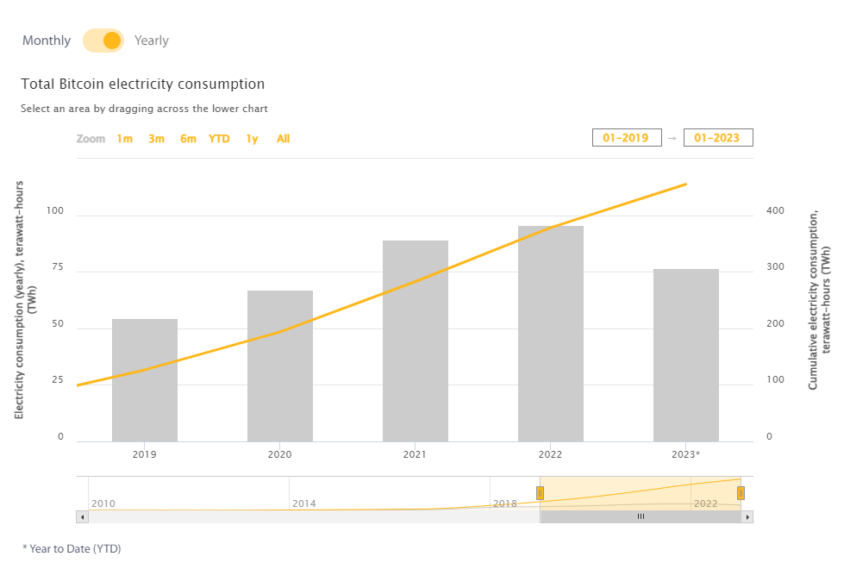Bitcoin’s environmental footprint is looking increasingly less alarming, as recent findings from the Cambridge Centre for Alternative Finance (CCAF) reveal. The electricity consumption of mining the Bitcoin network has been revised to 89 Terawatt hours (TWh), which is 15 TWh lower than previous estimates.
These surprising yet positive revelations offer a new vantage point for assessing Bitcoin’s long-term sustainability.
Bitcoin Environmental Impact
Historical data from CCAF reveals that previous electricity consumption estimates have been recalibrated, causing a paradigm shift in our understanding of Bitcoin’s environmental impact.
Before 2021, consumption estimates remained relatively consistent. A divergence first appeared in 2021 when Bitcoin’s electricity consumption was initially calculated to be 104 TWh.
However, the new model shows the number to be just 89 TWh, significantly smaller than first thought.
The 2022 estimates were also revised from 105.3 TWh to 95.5 TWh. This is similar to the energy consumption of countries like Belgium or the Netherlands.

As of 2023, year-to-date consumption has dropped further to 70.4 TWh, shedding light on a lesser-known facet of the cryptocurrency — its improving energy efficiency.
The CCAF attributes the change to a revised model that assesses the efficiency of older mining devices more accurately. Older devices, previously given equal weight in electricity consumption estimates, are now evaluated based on their release dates. This adjustment has led to the downward revision of Bitcoin’s annual electricity consumption.
Furthermore, Bitcoin’s hardware efficiency has been showing promising improvements. Efficiency is quantified in joules per terahash (J/TH), representing the electricity required to perform computational work.
The revised model indicates that the mining hardware efficiency for 2021 was 63.6 J/TH, which is notably better than the previous estimate of 74.2 J/TH.
Read more: What Is Bitcoin? A Guide to the Original Cryptocurrency
Bitcoin Energy Consumption
Though electricity consumption is crucial for assessing Bitcoin’s environmental footprint, it is only one aspect. The energy sources employed in Bitcoin mining, as well as their geographic distribution, play significant roles.
Researchers are continuously exploring other factors, including the potential to mitigate methane emissions by co-locating mining operations with oil fields or utilizing waste-heat recovery systems. These innovative approaches may offer avenues to further diminish Bitcoin’s environmental impact.
Read more: How To Mine Cryptocurrency: A Step-by-Step Guide
Reliable data on Bitcoin’s environmental impact remains ongoing. It is pivotal for researchers to adapt to new information to maintain the reliability of their estimates.
The latest findings from CCAF, a research initiative supported by leading public and private institutions, represent a noteworthy advancement in this endeavor. Their commitment to open-access research provides vital data to stakeholders and contributes to a more balanced public discourse.
While Bitcoin’s electricity consumption remains elusive, the recent downward revisions in energy estimates usher in a more optimistic outlook.
In adherence to the Trust Project guidelines, BeInCrypto is committed to unbiased, transparent reporting. This news article aims to provide accurate, timely information. However, readers are advised to verify facts independently and consult with a professional before making any decisions based on this content.
This article was initially compiled by an advanced AI, engineered to extract, analyze, and organize information from a broad array of sources. It operates devoid of personal beliefs, emotions, or biases, providing data-centric content. To ensure its relevance, accuracy, and adherence to BeInCrypto’s editorial standards, a human editor meticulously reviewed, edited, and approved the article for publication.


